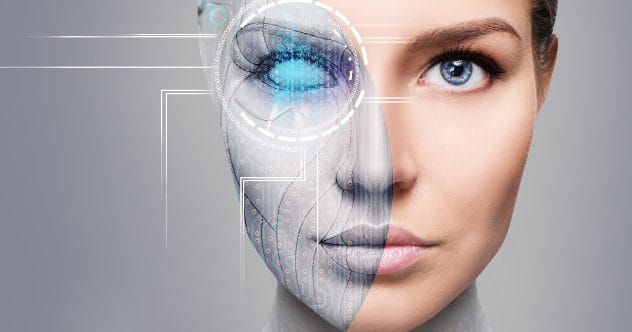What if the line between human and machine started to blur? For decades, cyborgs – beings part human, part machine – were staples of science fiction. But guess what? That fiction is rapidly becoming fact. Groundbreaking technologies are emerging every day, offering ways to enhance, repair, and even upgrade our physical bodies. It’s an exciting, and perhaps a little unnerving, time to be alive!
Forget far-off futures; the age of human augmentation is dawning right now. From microchips under our skin to bionic eyes, we’re exploring incredible advancements. Let’s dive into 10 amazing technologies that are bringing us closer to being cyborgs than ever before.
10. Robotic Exoskeleton
Imagine strapping on a suit that gives you superhuman strength or helps you walk again. That’s the promise of robotic exoskeletons! Companies like Roam Robotics are leading the charge. They specialize in inflatable robotic exoskeletons, making them lightweight and adaptable.
Their product, Ascend, is a game-changer for people with knee pain. It’s a wearable robotic brace that improves mobility and offers pain relief, helping users tackle tasks they thought were out of reach. Then there’s Forge, designed for more general use. Think firefighters, soldiers, or even outdoor enthusiasts getting a boost in strength and endurance. These exoskeletons are literally enhancing human performance, one step at a time.
9. Artificial Heart
The heart is a vital organ, and when it fails, the consequences can be dire. But what if we could replace it with a machine? In February 2021, the FDA approved Carmat’s artificial heart, AESON, for use in a patient for the first time in U.S. history. This incredible device is designed for individuals with biventricular heart failure, meaning both sides of their heart are failing.
Currently, AESON acts as a bridge, keeping patients alive while they await a traditional heart transplant. But the long-term goal is for these artificial hearts to last for years. AESON is unique because it automatically adjusts blood flow based on the body’s signals. It even has a biological lining from cow tissue to reduce risks like blood clots and strokes. Patients carry an external battery pack, but the peace of mind and extended life it offers are priceless.
8. Pacemaker
Pacemakers might be one of the earliest examples of widely adopted cyborg technology. Invented back in 1958 by Dr. William Chardack, Dr. Andrew Gage, and engineer Wilson Greatbatch, the first electronic pacemaker was implanted in 1960. That patient lived for another ten months, a true pioneer on the path to becoming a cyborg!
Today, millions rely on pacemakers to prevent complications from irregular heartbeats. They’ve improved so much that we almost see them as commonplace. However, for those who wear them, the awareness of having an electronic device keeping their heart in rhythm is a daily reality. They even need to be mindful of things like x-ray machines and strong magnetic fields – a small reminder of their enhanced nature.
7. IQ Buds
Okay, let’s clear this up first: IQ Buds don’t actually boost your intelligence (as much as we might wish they did!). Created by David Cannington, co-founder of Nuheara, these earbuds are all about enhancing your hearing. Nuheara’s mission is to make personalized hearing solutions accessible to everyone.
So, what do they do? IQ Buds allow you to control your soundscape. You can turn up the volume on conversations you want to hear while dampening distracting background noise. They connect to your device via Bluetooth and have cool pre-set modes like “Plane,” “Street,” and “Restaurant.” While not a full hearing aid replacement, they share some functionalities and represent a more subtle, everyday form of human audio augmentation. The latest version, IQbuds2 MAX, shows just how sophisticated this tech has become.
6. Contact Lenses That Measure Glucose Levels
Imagine your contact lenses doing more than just correcting your vision. In 2014, Google patented a digital contact lens designed to monitor blood sugar (glucose) levels in people with diabetes. This is a fantastic leap forward, potentially ending the need for frequent, painful finger pricks.
How does it work? These smart lenses have tiny sensors embedded within them. A minuscule hole allows tears to reach the sensor, which then analyzes the glucose levels and transmits this information to another device. It’s a non-invasive, continuous way for diabetes patients to manage their condition. This tech is helping people see a brighter, more convenient future for their health management.
5. A Microchip That Can Store Data in Your Hands
We often say the world is in our hands with smartphones, but some people are taking that literally! Australian scientist Shanit Korporaal made headlines in 2016 when she implanted two microchips into her hands. These tiny chips can replace IDs, credit cards, and even store passwords to log her into her computer.
This has sparked a “biohacker” movement, particularly in Australia. Even companies are getting in on it. The Swedish company Epicenter started implanting microchips in its workers back in 2015 using Near Field Communication (NFC) technology. These chips are passive, meaning they don’t actively gather new information but can be scanned to open doors or make payments. It’s a bold step into a directly integrated digital life.
4. Smart Bones
When bones are damaged, healing can be a long and complex process. But what if we could use a material that perfectly mimics human bone? That’s the idea behind SmartBone, created by IBI, a Swiss biotech company. Introduced in 2012, SmartBone is a bone substitute designed to feel and act just like the real thing.
It’s made by combining a bovine (cow) mineral bone matrix with special bioresorbable polymers and collagen fragments. The result? A material that shares key characteristics with healthy human bone: it’s biocompatible, has the right kind of porosity for cells to grow into, offers good mechanical strength, and interacts well with body fluids. This incredible innovation is already being used in various medical procedures, helping to rebuild bodies from the inside out.
3. BrainGate
The power of the mind directly controlling the physical world sounds like something from a superhero movie. Yet, BrainGate technology is making it a reality. Developed by neuroscientists at Brown University, BrainGate uses electrodes implanted into a patient’s brain to interpret neural signals and translate them into commands for external devices or even their own muscles.
This has been life-changing for individuals with paralysis. For instance, in 2017, Bill Kochevar, a man paralyzed for eight years, had a BrainGate device implanted. After months of training, he was able to feed himself and drink independently by using his thoughts to control his arm movements via the electrodes. While still in development and not yet widely available, BrainGate offers tremendous hope and demonstrates the profound potential of brain-computer interfaces.
2. Open Artificial Pancreas System (OpenAPS)
Managing Type 1 Diabetes can be a constant balancing act. But what if a system could automate much of that work? That’s where the Open Artificial Pancreas System (OpenAPS) comes in. Invented by Dana Lewis, who herself lives with Type 1 Diabetes, OpenAPS is a do-it-yourself (DIY) approach to creating a closed-loop system for glucose management.
The system works by communicating with an insulin pump and a Continuous Glucose Monitor (CGM). It gets data on recent insulin doses and current blood sugar levels, then automatically issues commands to the insulin pump to adjust insulin delivery as needed. As its name suggests, OpenAPS is an open-source project, meaning the information and technology are freely available. This has empowered many people with diabetes worldwide to build their own systems and better manage their health.
1. Second Sight and Pixium Vision
The idea of a bionic eye is perhaps one of the most classic cyborg concepts. While we’re not quite at laser-shooting eyeballs yet, incredible devices are restoring a degree of sight to the visually impaired! Companies like France’s Pixium Vision (with their IRIS device) and U.S.-based Second Sight are at the forefront.
Second Sight’s Argus II is particularly noteworthy as it’s considered the first fully bionic, electromechanical eye. It’s designed to provide functional vision by using a small camera mounted on the patient’s glasses. This camera captures images, which are then converted into electrical pulses and transmitted wirelessly to an implant on the retina. The implant stimulates the retina, sending signals to the brain that are perceived as patterns of light, allowing users to discern shapes and movement. It requires surgery and isn’t perfect vision, but for many, Argus II is a miracle, bringing light back into their world.
These ten technologies are just the tip of the iceberg. As science and engineering continue to advance, the ways we can augment and enhance the human body will only grow. We truly are living in an exciting era where the possibilities seem limitless.
The journey into a cyborg future is well underway, bringing with it new capabilities, ethical considerations, and a redefinition of what it means to be human. What was once confined to the pages of comic books and the silver screen is now part of our evolving reality.
What do you think of these cyborg technologies? Which one amazes you the most? Share your thoughts in the comments below!










